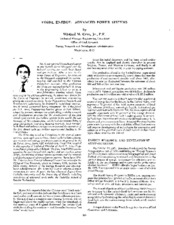| dc.contributor.other | Turbomachinery Symposium (4th : 1975) | |
| dc.creator | Crim, Winfred M. | |
| dc.date.accessioned | 2017-10-05T14:57:47Z | |
| dc.date.available | 2017-10-05T14:57:47Z | |
| dc.date.issued | 1975 | |
| dc.identifier.uri | https://hdl.handle.net/1969.1/163836 | |
| dc.description | Paper | en |
| dc.description | Pg. 153-157. | en |
| dc.description.abstract | The vast coal reserves of North America offer a potential source of energy far into the future. In the United States, coal represents 73 percent of the total known resources of fossil fuel, whereas petroleum, natural-gas liquids, and natural gas together represent only 9 percent. Yet, the consumption of coal annually represents only 21 percent of the energy demand, with the other forms of fossil fuels supplying some 75 percent. In the future, the nation will continue to demand energy in its cleaner and more convenient forms. Bringing the consumption pattern into harmony with the availability of fossil fuel reserves will require development of technologies for conversion and utilization of the plentiful types of fossil fuels to replace those types whose reserves are limited. | en |
| dc.format.medium | Electronic | en |
| dc.format.mimetype | application/pdf | |
| dc.language.iso | en | |
| dc.publisher | Texas A&M University. Gas Turbine Laboratories | |
| dc.relation.ispartof | Proceedings of the 4th Turbomachinery Symposium | en |
| dc.subject.lcsh | Turbomachines | en |
| dc.title | Fossil Energy: Advanced Power Systems | en |
| dc.type.genre | Presentation | en |
| dc.type.material | Text | en |
| dc.identifier.doi | https://doi.org/10.21423/R1XT2P | |


